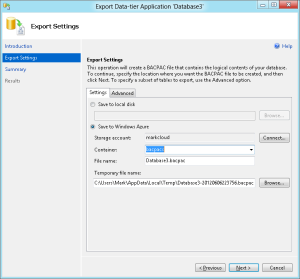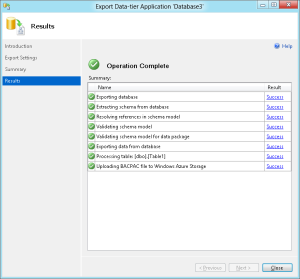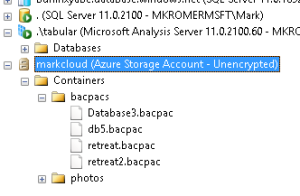SQL Server 2012 inlcudes new & updated features to SQL Server Management Studio (SSMS) that provide out-of-the-box integration into the Windows Azure platform-as-a-service Cloud service from Microsoft. It goes beyond just SQL Azure integration as you can now also connect into Windows Azure storage accounts where you can store files and blobs, including DACPAC & BACPAC files, essentially providing DBAs with out-of-the-box backup-to-cloud capabilities.
From a DBA’s perspective, this can be very beneficial because this would allow you to take your SQL Server backups and post them into the Azure cloud where files are automatically protected and replicated for high availability. This will also eliminate the need for you to maintain infrastructure for backups locally on your site. You would utilize Azure Storage for maintenance, retrieval and disaster recovery of your database backups. Here is a link with more details on Azure Storage.
Here are the steps to backup from SSMS 2012 to Windows Azure:
- First thing to note is that you will need to sign-up for a Windows Azure account and configure a storage container. You can click here for a free trial.
- Now, on SSMS, choose a database to backup. But instead of the normal Backup task, select “Export Data-Tier Application”. This is going to walk you through the process of exporting the schema with the data as a “BACPAC” file output.
3. On the next screen in the wizard, you will select the Azure storage account and container where SQL Server will store the export. Note that it will first backup the database (schema & data) to a local file and then upload it to the cloud for you.
4. Once the process is complete, you will see your exported backup as a BACPAC in your storage container. To restore a BACPAC, you right-click on the file from your container and select “Import Data-Tier Application”.
BTW, this process is identical to the way that you can export & import databases in SQL Azure. You can also easily now move your databases (schema and/or data) to and from SQL Server and SQL Azure with these BACPACs. This is not a full-service TLOG and data file backup like SQL Server native backups. This is more of a database export/import mechanism. But that is pretty much the most interactive that a DBA will get with SQL Azure anyway because you do not perform any TLOG maintenance on SQL Azure database. Microsoft takes care of that maintenance for you.




